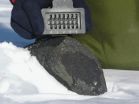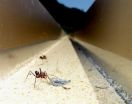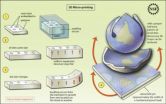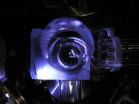(Press-News.org) Detergents are everywhere – in washing powders, dishwashing liquids, household cleaners, skin creams, shower gels, and shampoos. It is the detergent that loosens dirt and fat, makes hair-washing products foam up and allows creams to be absorbed quickly. Up until now, most detergents are manufactured from crude oil – a fossil fuel of which there is only a limited supply. In their search for alternatives, producers are turning increasingly to detergents made from sustainable resources, albeit that these surfactants are usually chemically produced. The problem is that the substances produced via such chemical processes are only suitable for a small number of applications, since they display only limited structural diversity – which is to say that their molecular structure is not very complex. Now researchers at the Fraunhofer Institute for Interfacial Engineering and Biotechnology IGB are taking a different approach: they are manufacturing surfactants using biotechnological methods, with the assistance of fungi and bacteria. "We produce biosurfactants microbially, based on sustainable resources such as sugar and plant oil," says Suzanne Zibek, a technical biologist and engineer at the IGB in Stuttgart. The scientist and her team use cellobiose lipids (CL) and mannosylerythritol lipids (MEL) because testing has shown these to be promising for industrial application. They are produced in large quantities by certain types of smut fungus, of the kind that can affect corn plants. What is more, CL also has antibacterial properties.
What marks biological surfactants out from their synthetic competitors is their increased structural diversity. In addition, they are biodegradable, are less toxic and are just as good at loosening fats. But despite all this, to date they are used in only a few household products and cosmetics. The reason is that they are costly and difficult to produce, with low yields. One substance that has been successfully brought to market is the sophorose lipid made by Candida bombicola, which is used by a number of manufacturers as an additive in household cleaning products. This biosurfactant is produced by a yeast that is harvested from bumble-bee nectar.
"If we want natural surfactants to conquer the mass market, we need to increase fermentation yields," says Zibek. To this end, the scientists are optimizing the production process in order to bring down manufacturing costs. They cultivate the microorganisms in a bioreactor, where they grow in a continuously stirred culture medium containing sugar, oil, vitamins and minerals salts. The goal is to achieve high concentrations in as short a time as possible, so they need to encourage as many microorganisms as possible to grow. There are numerous factors with a bearing on the outcome, including the oxygen supply, the pH value, the condition of the cells, and the temperature. The composition of the culture medium itself is also crucial. It is not just a question of how much sugar and oil go into the mix, but also the speed at which they are added. "We have already achieved concentrations of 16 grams per liter for CL and as high as 100 grams per liter for MEL – with a high production rate, too," the group manager is happy to report.
The next step is to separate the biosurfactants from the fermentation medium and to characterize them with the help of industrial partners, determining which surfactants are suitable for use in dishwashing liquids, which are more suited to oven cleaning products, and which are ideal for use in cosmetics. The substances can finally be modified or improved at the enzymatic level. "For instance, we managed to increase wa-ter solubility. After all, the biosurfactant shouldn't form an oily film over the surface of the dishwashing liquid," explains Zibek. The experts have even managed to produce biological surfactants using waste products, by obtaining the sugar needed for the culture medium from straw. The researchers will be presenting biosurfactants they have produced themselves at HANNOVER MESSE from April 23 to 27, 2012 (Hall 2, Booth D22).
INFORMATION:
Environmentally friendly cleaning and washing
2012-03-12
ELSE PRESS RELEASES FROM THIS DATE:
TacSat-4 enables polar region SatCom experiment
2012-03-12
WASHINGTON -- The U.S. Coast Guard Cutter HEALY (WAGB 20) successfully experimented with NRL's TacSat-4 communications satellite, Jan. 24, by communicating from the Bering Sea off the western coast of Alaska to Coast Guard Island, Alameda, Calif.
Returning from an escort and icebreaking mission to Nome, Alaska, assisting the Russian tanker Renda delivery of emergency fuel to the town, USCGC HEALY — Coast Guard's only polar icebreaker — was approximately 260 nautical miles south of the Arctic Circle at the time of the test.
Deployed into a unique, highly elliptical ...
Mapping the Moho with GOCE
2012-03-12
The first global high-resolution map of the boundary between Earth's crust and mantle – the Moho – has been produced based on data from ESA's GOCE gravity satellite. Understanding the Moho will offer new clues into the dynamics of Earth's interior.
Earth's crust is the outermost solid shell of our planet. Even though it makes up less than 1% of the volume of the planet, the crust is exceptionally important not just because we live on it, but because is the place where all our geological resources like natural gas, oil and minerals come from.
The crust and upper mantle ...
Meteorites reveal another way to make life's components
2012-03-12
Creating some of life's building blocks in space may be a bit like making a sandwich – you can make them cold or hot, according to new NASA research. This evidence that there is more than one way to make crucial components of life increases the likelihood that life emerged elsewhere in the Universe, according to the research team, and gives support to the theory that a "kit" of ready-made parts created in space and delivered to Earth by impacts from meteorites and comets assisted the origin of life.
In the study, scientists with the Astrobiology Analytical Laboratory ...
Infection control certification associated with lower MRSA infection rates
2012-03-12
Washington, DC, March 9, 2012 -- Hospitals whose infection prevention and control programs are led by a director who is board certified in infection prevention and control have significantly lower rates of methicillin-resistant Staphylococcus aureus (MRSA) bloodstream infections (BSI) than those that are not led by a certified professional, according to a new study published in the March issue of the American Journal of Infection Control, the official publication of APIC - the Association for Professionals in Infection Control and Epidemiology.
A team of researchers ...
Orientation of desert ants: Every cue counts
2012-03-12
Desert ants have adapted to a life in a barren environment which only provides very few landmarks for orientation. Apart from visual cues and odors the ants use the polarized sunlight as a compass and count their steps in order to return safely to their home after searching for food. In experiments with ants of the genus Cataglyphis in their natural habitats in Tunisia and Turkey, behavioral scientists of the Max Planck Institute for Chemical Ecology in Jena, Germany, have now discovered that ants can also use magnetic and vibrational landmarks in order to find their way ...
Researchers 'print' polymers that bend into 3-D shapes
2012-03-12
Christian Santangelo, Ryan Hayward and colleagues at the University of Massachusetts Amherst recently employed photographic techniques and polymer science to develop a new technique for printing two-dimensional sheets of polymers that can fold into three-dimensional shapes when water is added. The technique may lead to wide ranging practical applications from medicine to robotics
The journal Science publishes the research in its March 9 issue.
Researchers used a photomask and ultraviolet (UV) light to "print" a pattern onto a sheet of polymers, a technique called photolithography. ...
Genetic marker for painful food allergy points to improved diagnosis, treatment
2012-03-12
Researchers have identified a genetic signature for a severe, often painful food allergy – eosinophilic esophagitis – that could lead to improved diagnosis and treatment for children unable to eat a wide variety of foods.
The scientists, from Cincinnati Children's Hospital Medical Center, report in the Journal of Allergy and Clinical Immunology that they have pinpointed a dysregulated microRNA signature for eosinophilic esophagitis (EoE), a disease that also may cause weight loss, vomiting, heartburn and swallowing difficulties.
Interestingly, the dysregulated microRNA ...
New 'pendulum' for the ytterbium clock
2012-03-12
The faster a clock ticks, the more precise it can be. Due to the fact that lightwaves vibrate faster than microwaves, optical clocks can be more precise than the caesium atomic clocks which presently determine time. The Physikalisch-Technische Bundesanstalt (PTB) is even working on several of such optical clocks simultaneously. The model with one single ytterbium ion caught in an ion trap is now experiencing another increase in accuracy. At PTB, scientists have succeeded in exciting a quantum-mechanically strongly "forbidden" transition of this ion and – in particular – ...
Iridescent, feathered dinosaur: New evidence that feathers evolved to attract mates
2012-03-12
The detailed feather pattern and color of Microraptor--a pigeon-sized, four-winged dinosaur that lived about 120 million years ago--had a glossy iridescent sheen.
Its tail was narrow and adorned with a pair of streamer feathers, suggesting the importance of display in the early evolution of feathers, say scientists reporting the findings in this week's issue of the journal Science.
By comparing the patterns of pigment-containing organelles from a Microraptor fossil to those in modern birds, the scientists determined that the dinosaur's plumage was iridescent with a ...
NOHO Dental Group Now Offers Several Special Promotions for New and Existing Patients
2012-03-12
NOHO Dental Group and Dr. Afar, North Hollywood dentist, are offering a variety of specials for new and existing patients. For a short time, patients can receive discounts on a wide number of dental procedures, allowing both new patients and those who have been with the NOHO Dental Group for years to save money and try new dental services.
These specials include a wide variety of services, such as a $49 dental exam with x-rays for new patients. For patients who need preventative care like dental cleanings, this special allows new patients to try out the services of Dr. ...







